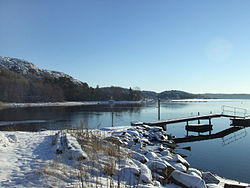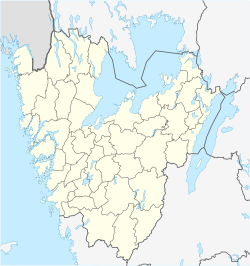Brofjorden
| Brofjorden | |
|---|---|

Northeast part of Brofjorden at Holländaröd
|
|
| Location | Västra Götaland County, Sweden |
| Coordinates | 58°21′35″N 11°25′26″E / 58.35972°N 11.42389°ECoordinates: 58°21′35″N 11°25′26″E / 58.35972°N 11.42389°E |
| River sources | Broälven |
| Primary outflows | Skagerrak |
| Max. length | 4 mi (6.4 km) |
| Frozen | shallow parts Jan-Feb |
| Islands |
|
| Sections/sub-basins | Trommekilen 58°21′09.3″N 11°26′46.6″E / 58.352583°N 11.446278°E |
Brofjorden is a fjord in Lysekil Municipality, Bohuslän, Sweden. It cuts into Västra Götaland County in a southwest–northeasterly direction between the Stångenäset and Härnäset peninsulas. Situated between Gullmarn and Åbyfjorden, it is the smallest of these fjords.
Brofjorden Port in the fjord is Sweden's largest oil port.
During the Stone Age, Bronze Age and Iron Age, Brofjorden was navigable as far up north as Brodalen. The shoreline has receded about 2 km (1.2 mi) to the south since then. The area has been filled in with silt and clay, leaving only the minor Broälven river in the middle of the former north part of the fjord. The surrounding area is rich with pre-Medieval archaeological finds. On Broberg hill are the remnants of a 12th century fort and the oldest parts of the nearby Bro Church, are from the Middle Ages.
The Ryxö island in the middle of Brofjorden, was a strategic point in the local waterways during the Bronze Age. There are number of cairns on the island and the adjacent shores.
When herring fishing peaked in the 17th and 18th century, fishing industries flourished all around Brofjorden. The primary products were salted herring and train oil made from boiled herring to extract the oil. The salted herring was sold to traders from Germany and Holland, and the train oil was exported to London, Paris and New York to be used in street lamps. The purest oil, filtrated ten times, was produced at Norra Grundsund just south of the mouth of Brofjorden.
At the beginning of the 20th century, there were several canned food factories around Brofjorden to process the herring and other sea food products. Because of the good quality of the water, there was an oyster farm in the fjord around 1920. By then most if the fishing industry had closed down. The herring fishing had declined and by 1915, mackerel had disappeared from the fjord, only subsistence fishing done by people living by the fjord remained. The canning factory at Sjöbol (58°21′13.4″N 11°26′03.5″E / 58.353722°N 11.434306°E) was later razed to make way for the product terminal at Brofjorden Port.
...
Wikipedia

